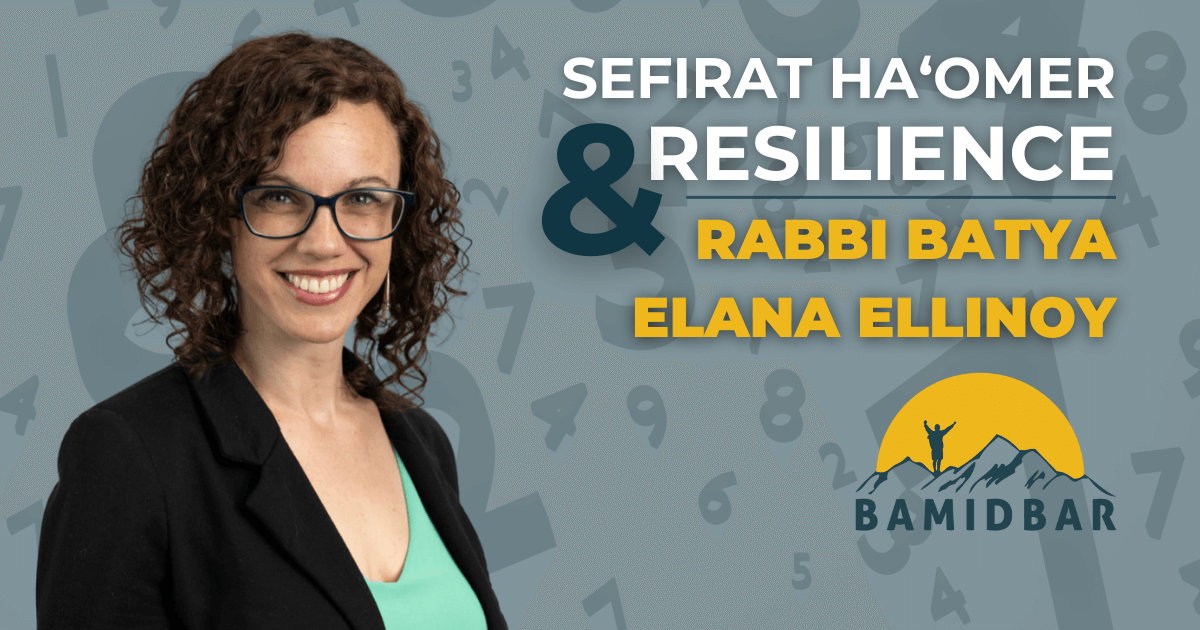Since the second night of Passover, it is customary for Jews to fulfill the mitzvah, or sacred obligation, of counting the Omer, tracking each of the 49 days and corresponding weeks until the next festival of Shavuot. For each day’s count, which begins when there are three stars in the sky, we stand, recite the blessing for counting, and then declare what day and week it is. This mitzvah of counting the Omer is just one example of a Jewish practice that could be seen through a lens of well-being as a seasonal resilience-promoting habit.
Resilience is understood as the ability to adapt to and recover from inevitable forms of stress and challenging experiences. The Harvard Center on the Developing Child outlines four protective factors that aid in resilience. These factors can be seen as essential ingredients reflected in many Jewish rituals and practices, including opportunities for cultivating and strengthening:
- Adaptive and Self-Regulation Skills
- Sense of Autonomy and Choice
- Cultivating Supportive Relationships
- Connections to Sources of Faith, Cultural Tradition, and Meaning Making
Let us explore how this practice of counting the Omer aligns with each of the above-named factors, thereby supporting our individual and collective resilience and well-being.
Strengthening Adaptive and Self-Regulation Skills
How do we count?
We stop what we are doing. We stand. We bless. And in order to know when to count (or in building an app to remind us!) we connect with nature, as we need to be attuned to the cycle of the sun and the stars in the sky. Each of these actions could be seen as skills that encourage self-regulation, the capacity to respond and manage one’s feelings and impulses in stressful situations.
Repetition of such ordinary acts of intentionally pausing to direct and focus our attention on the present moment, returning to the body (knowing that we are standing), and orienting to our relationship with the surrounding environment are key tools for regulation and adapting to stress. With this ongoing, mindful practice of a daily count, we are training our brains to co-regulate with the resource that is the present moment. This holds true even more so when we attach a blessing.
Strengthening a Sense of Autonomy and Choice
How do we count?
We use our voices! Traditionally, we start with an intention prior to the blessing stating, Heneini muchan/a u’mezuman/et l’kayem mitzvat aseh shel sefirat haomer…Here I am, ready and prepared to fulfill a sacred act of connection by counting the omer.
That first word says it all. Heneini: Here I am. Especially when it could be “easier” to shut down and succumb to the distress and distractions easily found in our world, or perhaps when we might not want to be interrupted from joy or beauty, we nevertheless still stand up to count and say: Heneini. Here I am, choosing to show up for this moment to acknowledge where we are on this journey of counting.
It is also noteworthy that this and other mitzvot that focus on keeping track of time is one that is given by God to the Israelites only after they are redeemed from slavery. Being able to count time is a sign of freedom and of no longer being a slave to someone or something else’s imposition of time. We are aware of time, of the days passing, and we utilize our sense of agency to say Heneini and acknowledge this awareness and offer a blessing over such telling of time.
Cultivating Supportive Relationships
How do we count?
We may count by ourselves or in community. Either way, we can know and sense that Jews are counting all over the world. We are not alone in our counting.
Some may choose to use this time of the Omer to join a study group or engage in a contemplative practice with a beloved or dear friends, cultivating closer connections with others and with oneself. Counting the Omer also connects us to the wisdom of our ancestors who engaged in various forms of this practice for millennia. They and their wisdom live on in us, and through our engagement, we can open ourselves up to their wisdom.
Strengthening Connections to Sources of Faith, Cultural Tradition, and Meaning Making
How do we count?
We engage in a form of practice and tradition that itself has adapted over the last 3,000 years. Originally, as an agricultural rite in Biblical times (marking the time between the barley and wheat harvest), our farmer ancestors would rise every night to wave their Omer, a measure of barely, praying for an abundant harvest that would sustain them and their loved ones.
Our rabbinic ancestors found a way to adapt this counting to be what we know it as today, acknowledging the Israelites’ journey through the wilderness (ba’midbar!) from liberation to revelation. Our mystic ancestors, the Kabbalists, found yet another way to engage in the practice by using it to explore and align ourselves with divine qualities that live within us.
Throughout these various adaptations (which continue to spark inspirational ways of engaging with this practice for healing), what we might come to observe is that regardless of the reason for the counting, engaging in this practice essentially means that we are making this moment count. It matters! And, as we are the ones doing the counting, so too then, we count! We matter!
At the heart of this practice, we are reminding ourselves and find meaning in knowing this moment in time counts, and I count with it.
When this knowledge is returned to, again and again, our capacity for resilience can emerge and grow, we can be in alignment with what matters most to us, and we can be deliberate in our actions and responses to whatever the Source of Life may reveal to us.
Taking It With You
How do YOU count? What are the impacts of counting for you?
And if counting the Omer is not a practice you take on, what is something that you do count or that you could imagine counting in which you might also sense these factors to be a part of that method?
What other connections do you make with the Omer counting practice and the various resilience factors?
I’d love to hear! Feel free to share your comments with me at batyae@bamidbartherapy.org.
Whether your tradition has been to count the Omer or whether you engage in another habit that promotes resilience, may we all continue to experience the blessings of individual and collective resilience made possible especially with ongoing moments for self-regulation, showing up to say Heneini, cultivating relationships, and making meaningful connections.
May such practices truly remind us that as we count, so too, we matter.
Rabbi Batya Elana Ellinoy is the Rabbi-in-Residence at BaMidbar.

